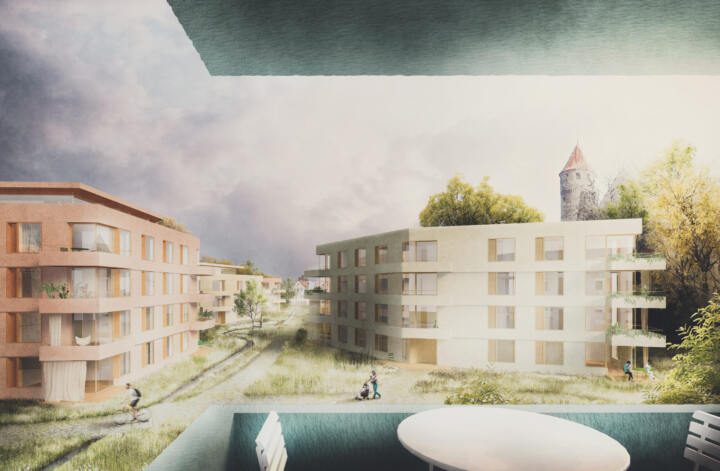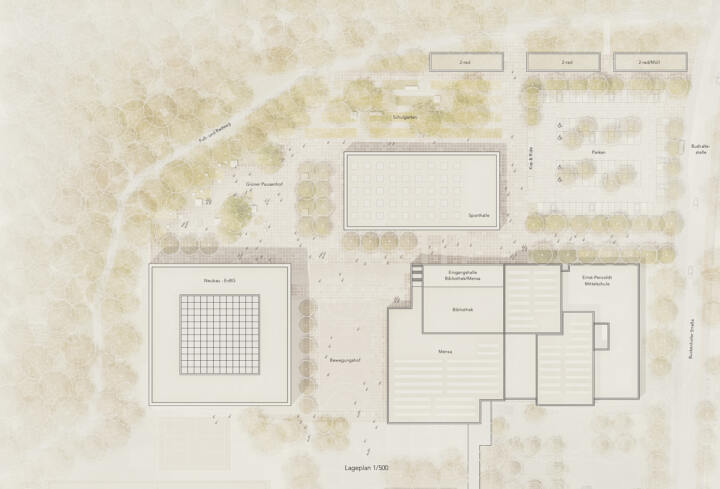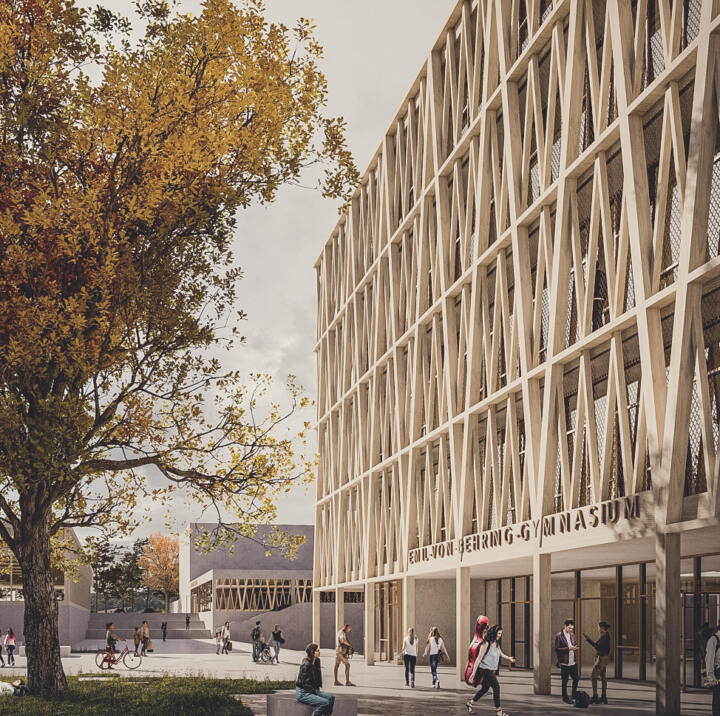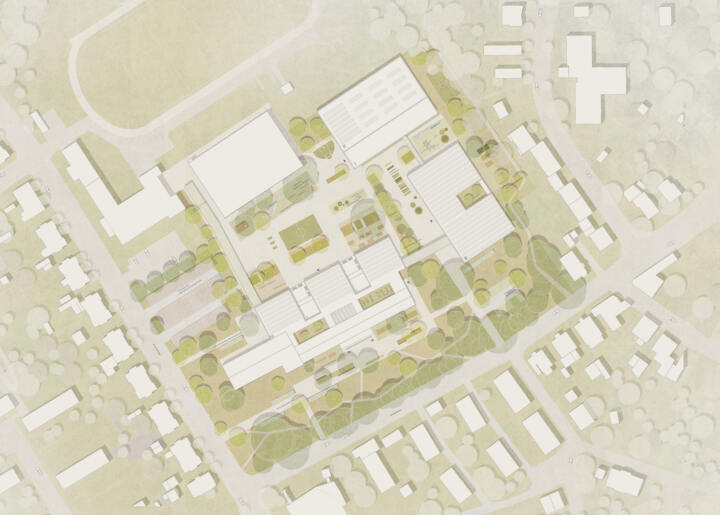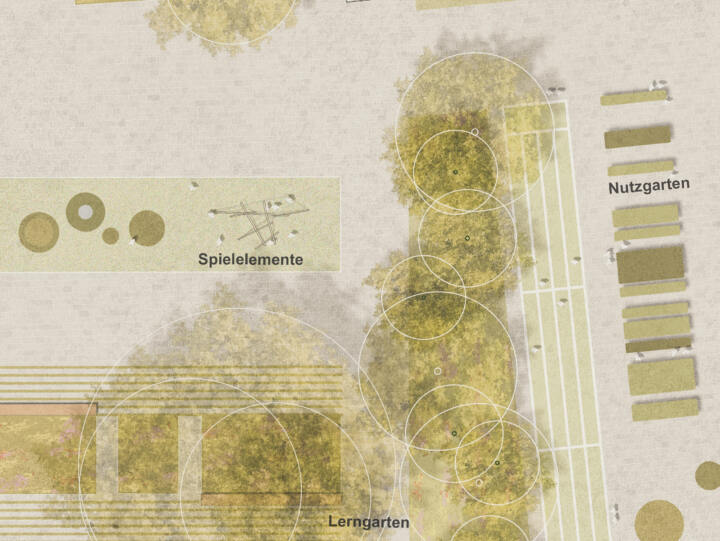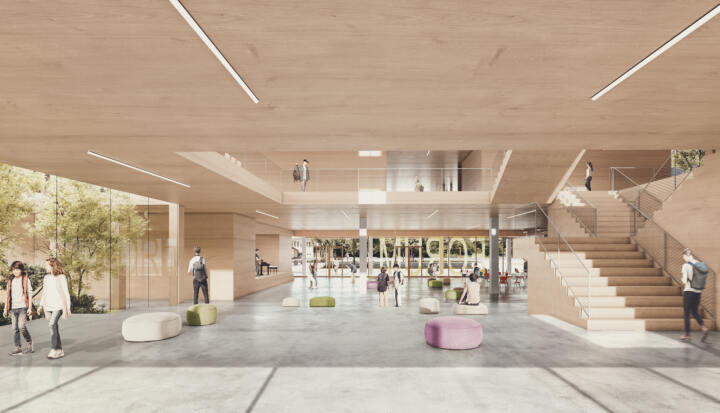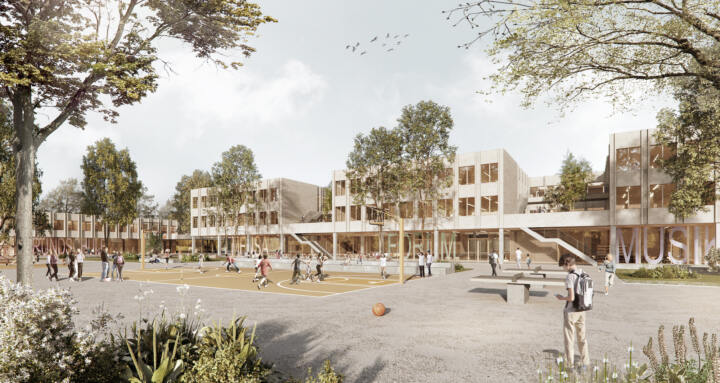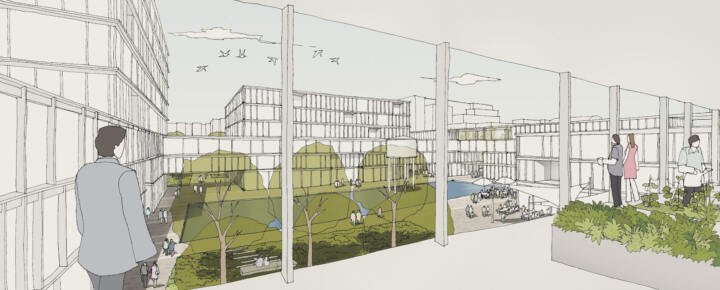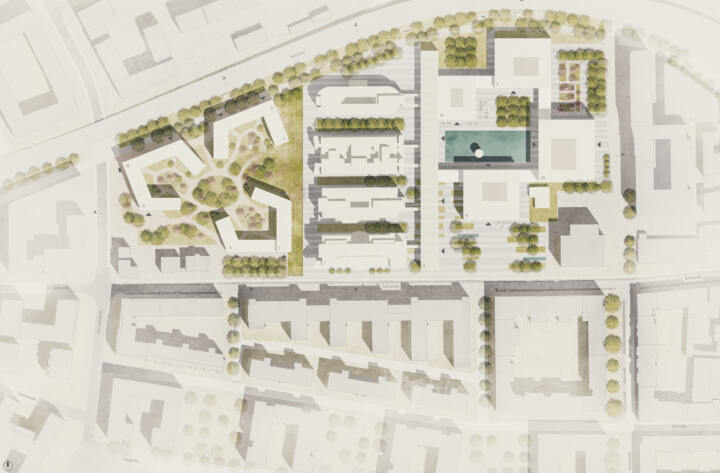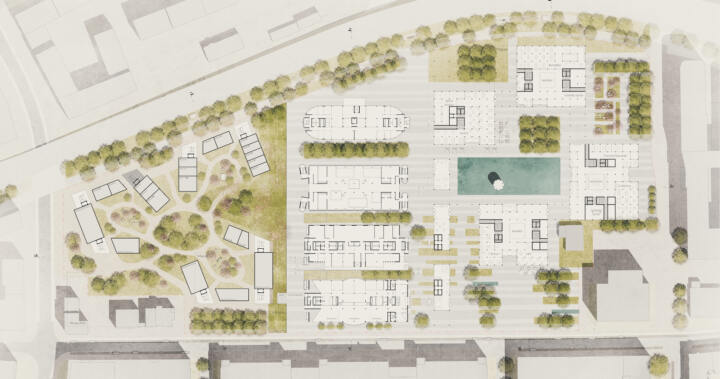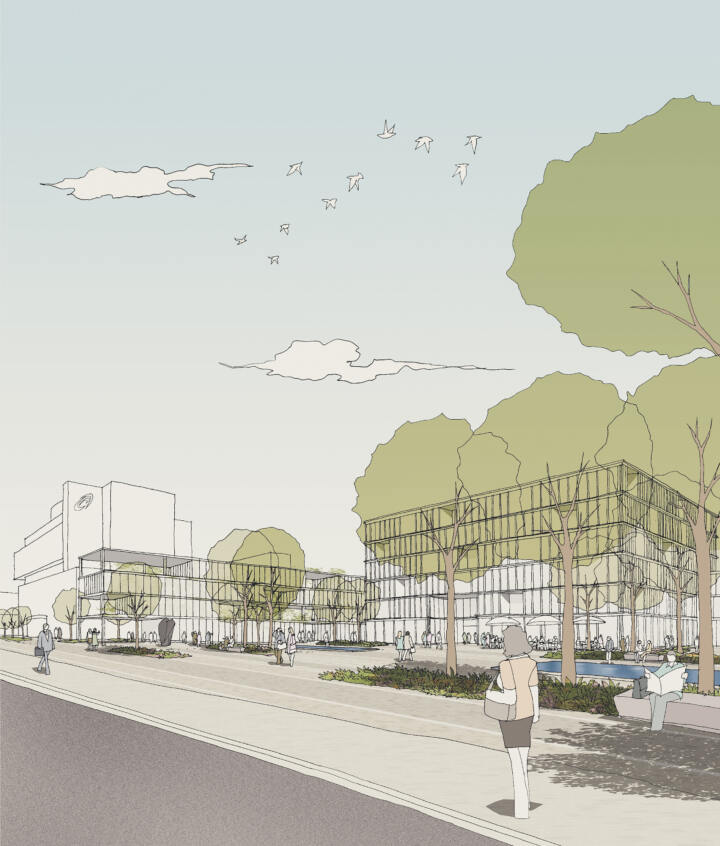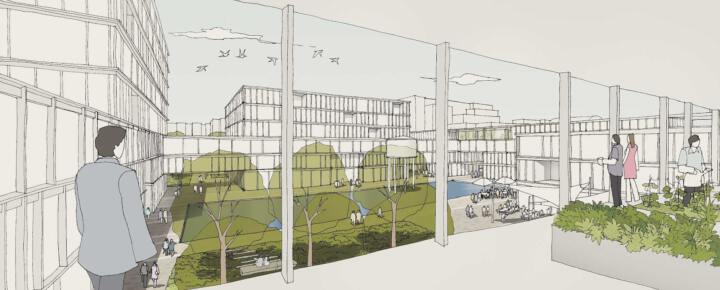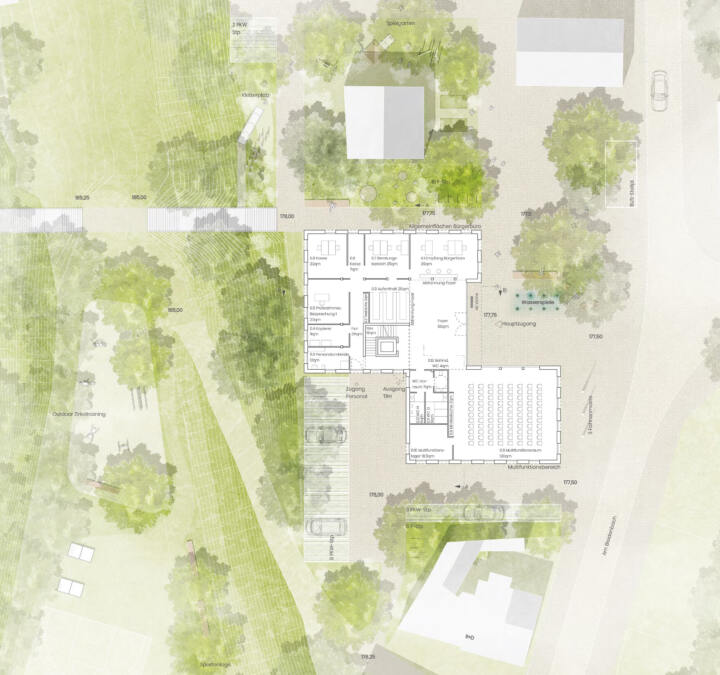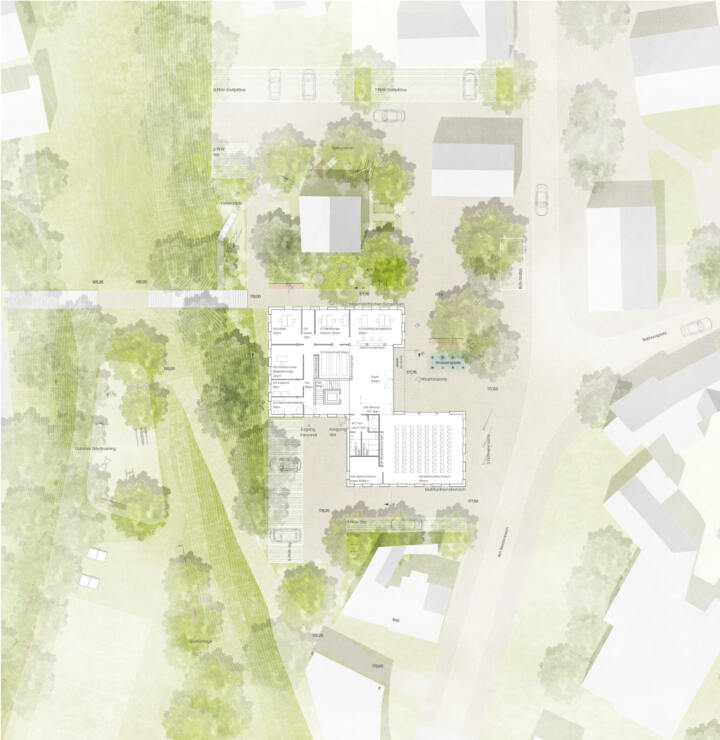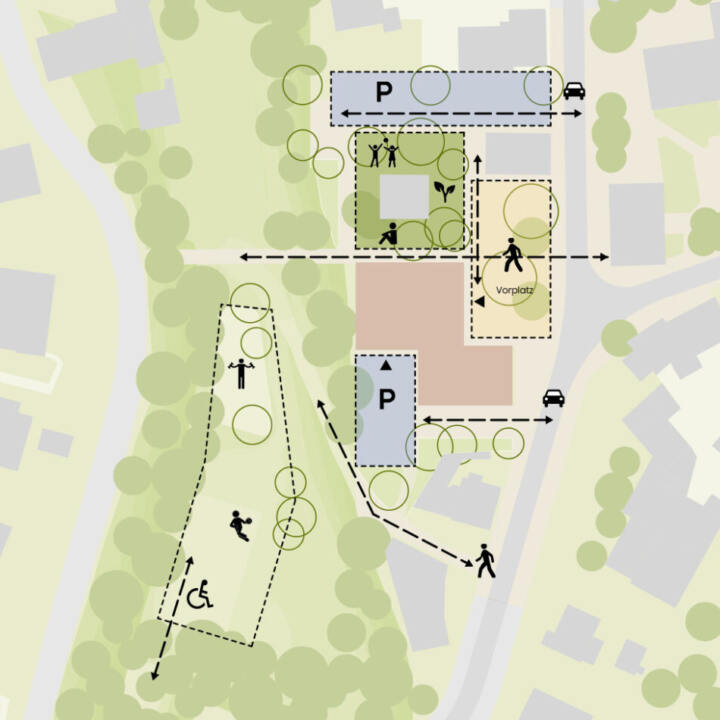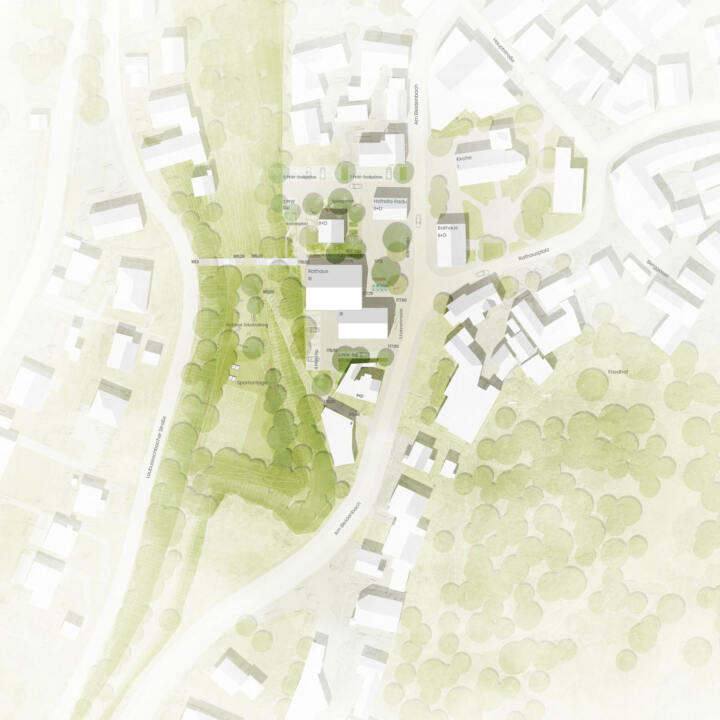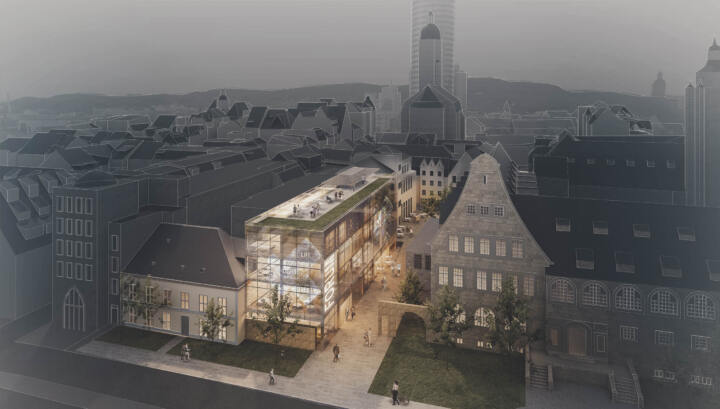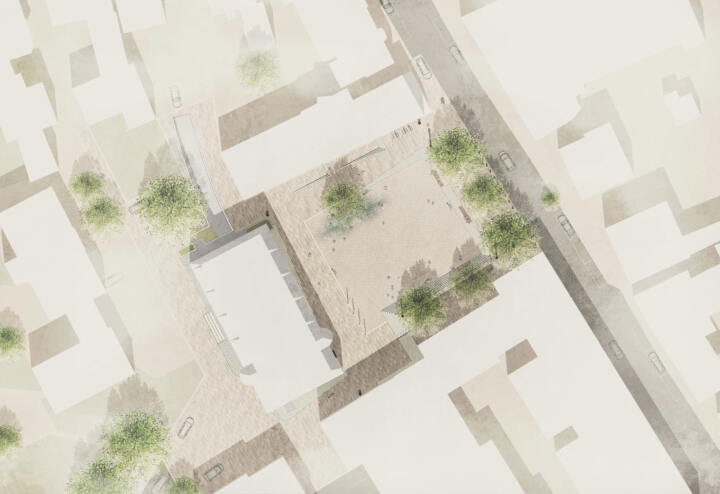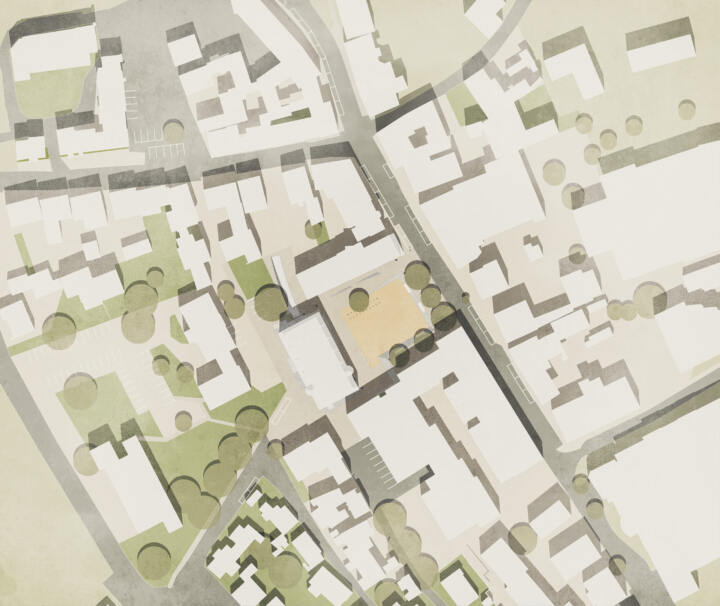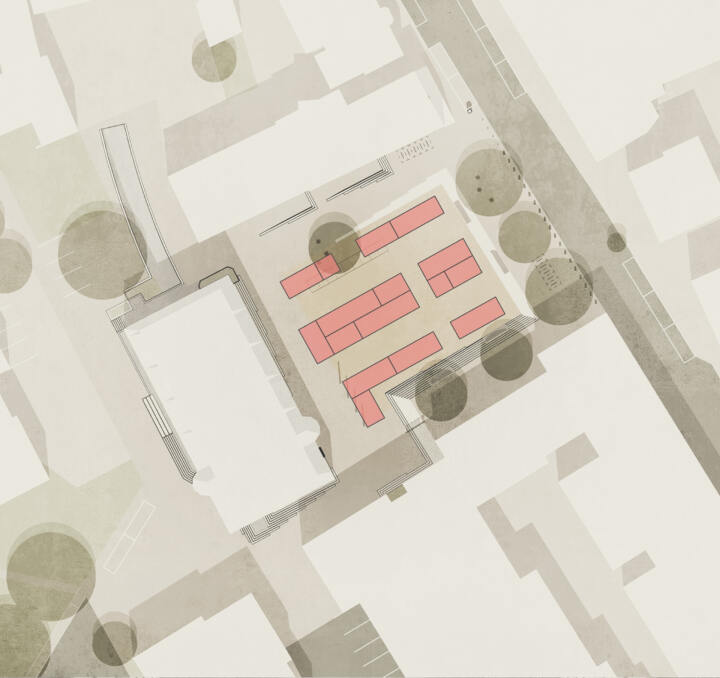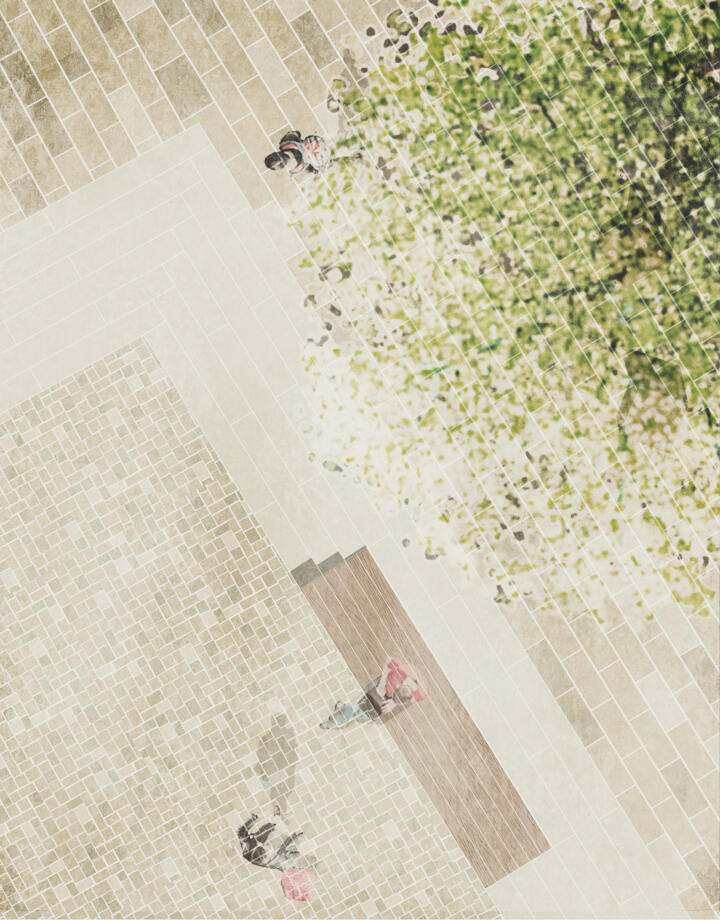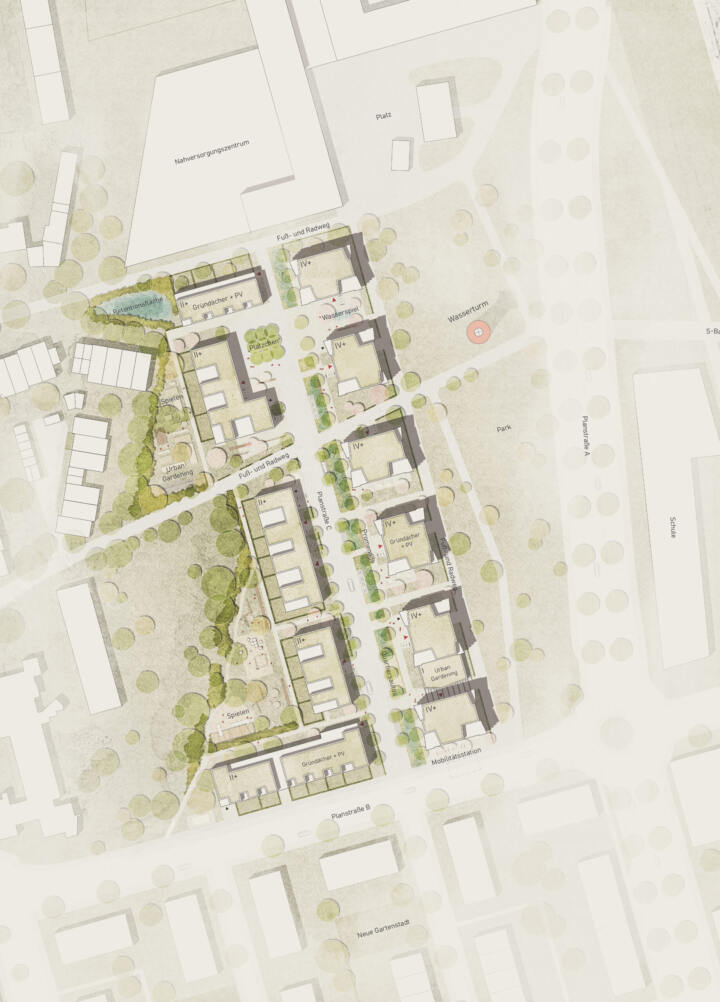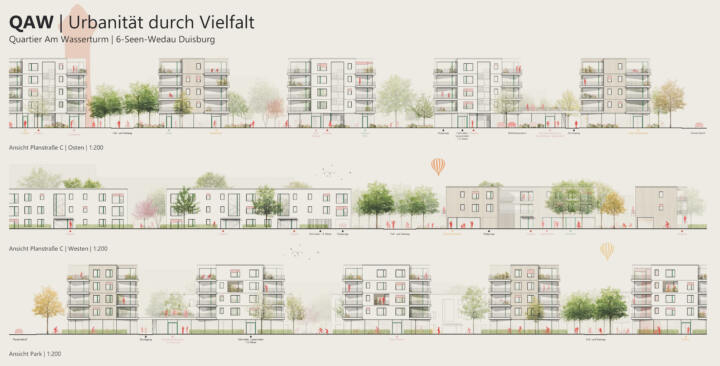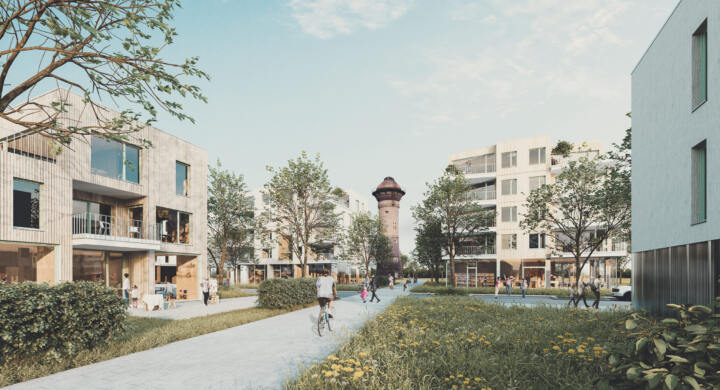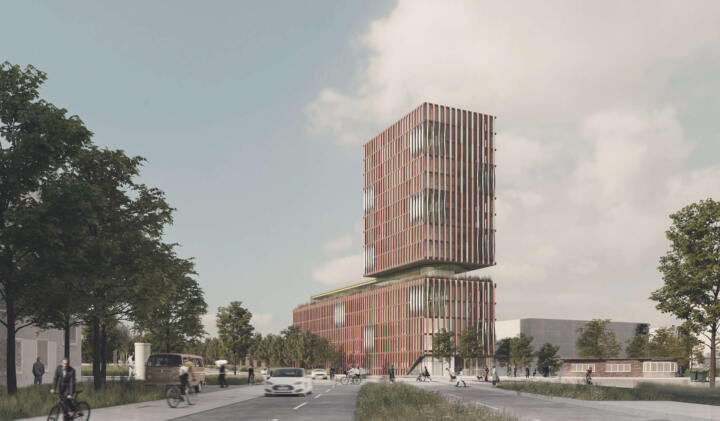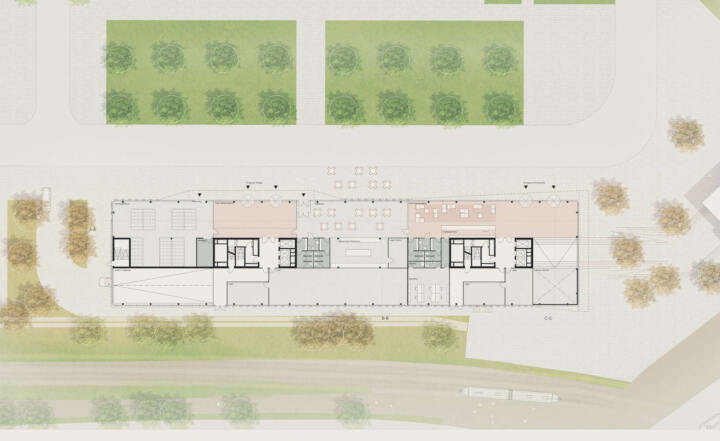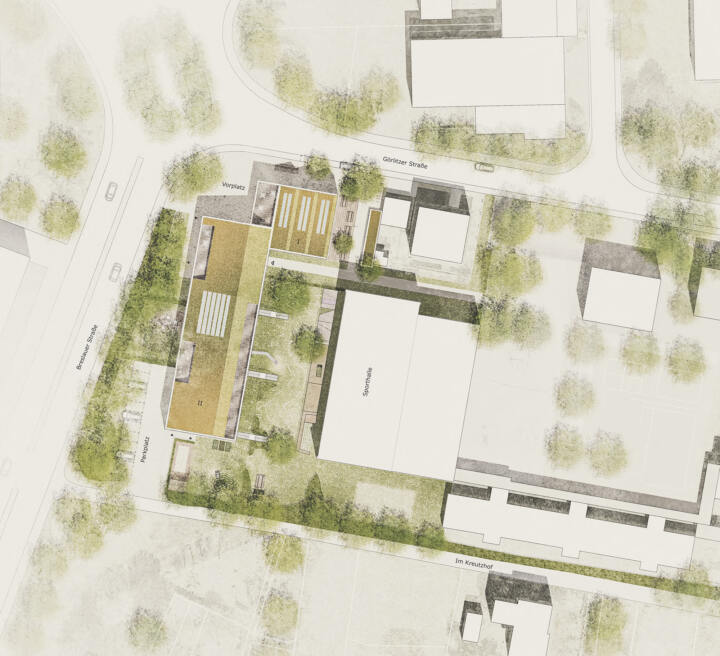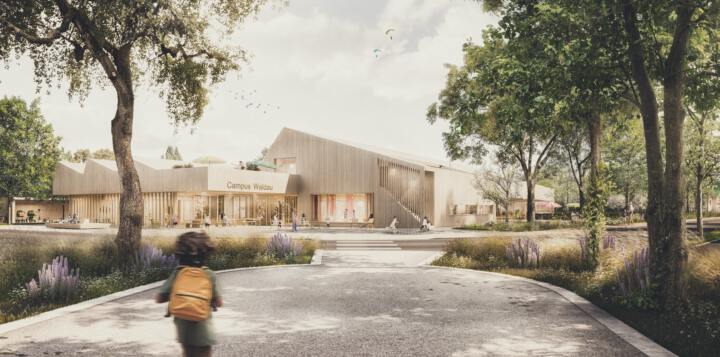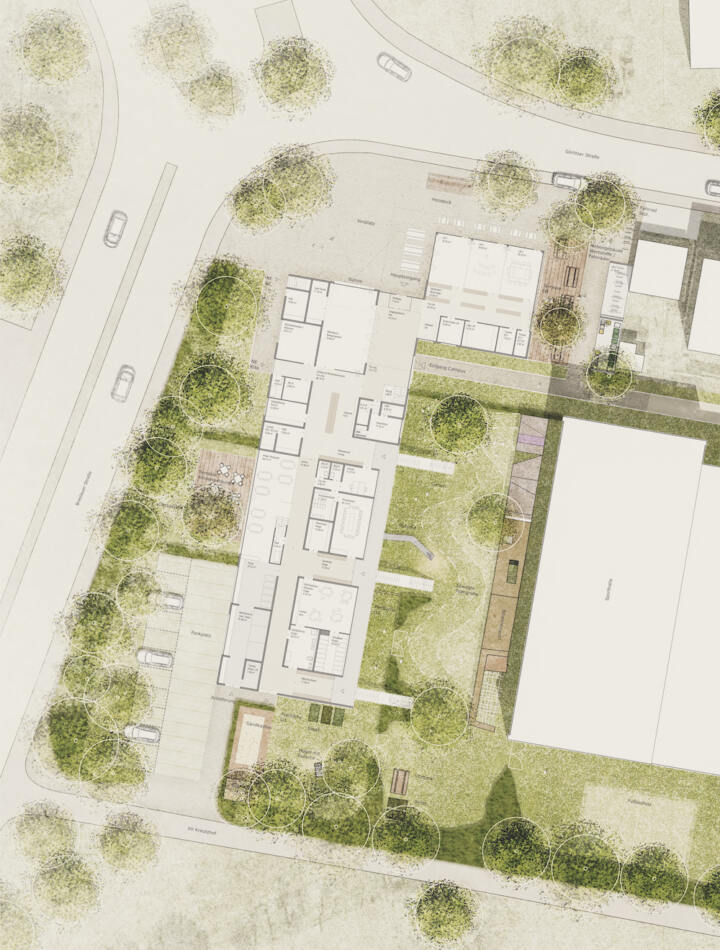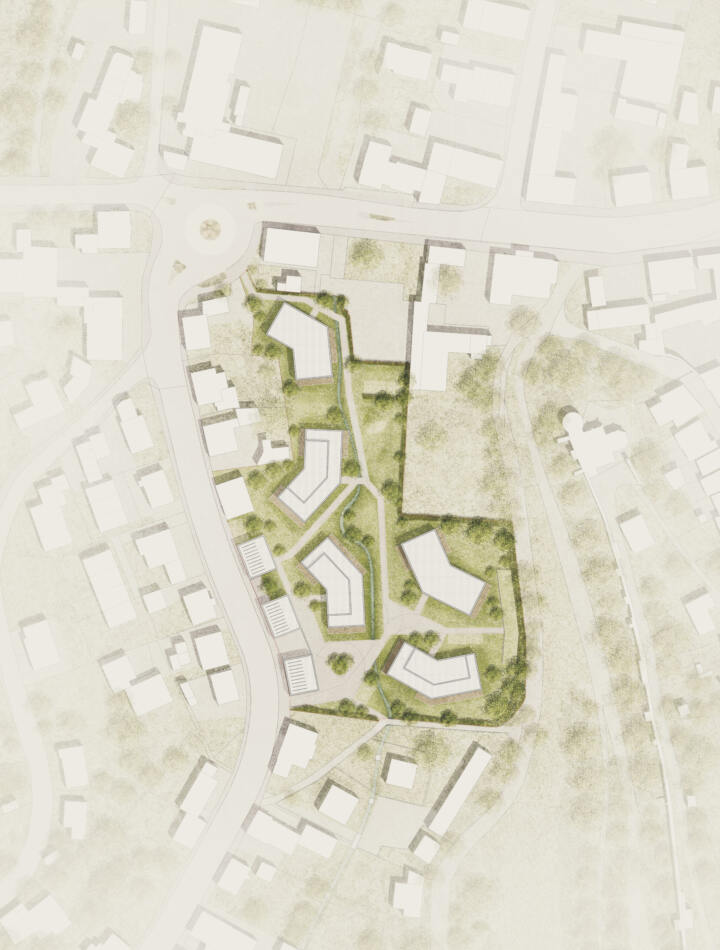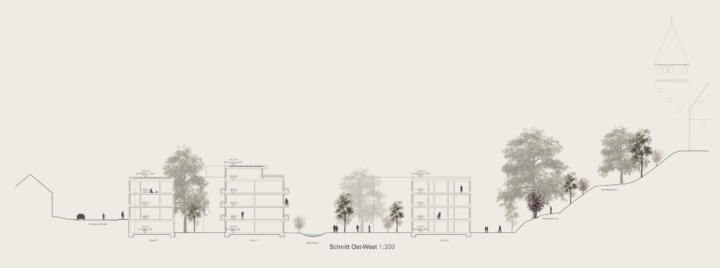Emil-von-Behring Secondary School | Spardorf
1. Prize | Emil-von-Behring Secondary School
Spardorf, Erlangen
In cooperation with Babler + Lodde Architekten
The open areas on the school campus are arranged as well-defined external spaces, while the existing topography is skilfully used to define the individual subspaces. These subspaces are effortlessly connected by means of a tiered arrangement of seating with integrated stairs and ramps. A square grid acts as a linking element, determining both the division and design of the interior spaces, as well as the squares and paths of external spaces. Geometric blocks and rows of trees take up the urban structure, accentuating the built context. A continuous surface made up of 1.25m x 1.25m slabs picks up on the building’s modular grid, tying the open spaces together. Variously sized seating decks are woven into this grid. In addition to three oak trees, all of which merit protection, a large number of existing trees can be preserved.
The lower-lying courtyard between the canteen and the secondary school accommodates an all-weather court. In future, should more open space be required, this function can be relocated to the roof of the new sports hall and the former area added to that of the schoolyard. All trees will be planted in generously dimensioned tree pits and these will be additionally irrigated via tree trenches so they can be permanently maintained, even in times of climate change.
School Campus Gellershagen | Bielefeld
3rd Prize | School Campus Gellershagen
Bielefeld
In Cooperation with Atelier 30 Architekten GmbH
With the new extension to the secondary school and the new buildings for the primary school and triple sports hall complex, building work to the school campus in the Schildesche neighbourhood has now been completed. The schoolyard is flanked on all sides by the school buildings, creating a protected area in which children can move around safely. Service areas are clearly zoned, while axial vistas and paths link the school campus with its urban neighbourhood.
These additional campus buildings set the context for a reorganisation of the open spaces around the campus, while also acknowledging the existing green belt on Schelpsheide. The secondary school is accessed centrally, either through the courtyard via the street “Am Brodhagen” or from Schelpsheide. At the heart of the campus lies the large playground, while a swathe of greenery separates the secondary school from the primary school. Dedicated areas for games are embedded in the uniform pavement of concrete pavers in finely nuanced shades of grey and beige. These areas are delineated by playful markings, by grass-permeable pavers or by colour, none of which present an obstacle to the children’s need to move around freely. Plenty of opportunities for primary school students to play – for example just romping around or climbing activities – are visually delineated by lines and fields in the surfacing, inspiring children to invent new hopping, running, and balancing games. Both the kitchen garden and the green classroom are located on the quiet east side. For secondary students, in addition to age-appropriate sports activities, there are outdoor teaching areas. Wherever possible, surface water is fed into the vegetation via tree trenches to improve the water supply to the foliage, which leads to an increase in evapotranspiration.
Mainova Campus Solmsstraße | Frankfurt
Recognition | Mainova Campus Solmsstraße
Frankfurt
In collaboration with hks Architekten GmbH Erfurt
Greenery galore!
The Mainova site on Solmsstrasse is being expanded, and the site‘s existing buildings integrated into the plan. A key elementary element – the so-called “connector” – links the existing structures with the new and will serve both as an access route and as a space for bringing people together across the entire extended campus. In the west, a residential area with courtyards and underground parking is being created, and in the east, the new campus. To meet various safety stipulations, this arrangement entails zoning the public and private open spaces differently. Traffic will be calmed to create new pedestrian routes between buildings for employees.
The open spaces on the Mainova Campus take their cue from the overall organization of open spaces around the site. Lines of trees will delineate the extent of greenery towards the railway line. On the northern site boundary this green corridor connects an area dedicated to recreation, sports and play via a green promenade.
On the site these green structures are linked into the residential quarter via the urban groves of trees. The urban feel of the entrance to the tunnel at Birkenweg that leads to the Schönhof quarter further emphasises its urban character. A green hub of shady copses at its centre is open to the public and provides recreational and quiet zones among the residences’ courtyards. These inner courtyards themselves offer a framework and space for neighbourly exchange surrounded by the green facades.
The linear “Green Hill” separating the campus from the residential area, provides parking spaces for e-mobility, and flanks onto the access route for campus traffic. Over the underground car park entrances and exits, intensively planted vegetation links the existing buildings within the campus. The forecourt acts as the entrance to the city and provides access to the Welcome Centre, Service Centre, a café and an exhibition space. The Mainova Campus offers employees, visitors and neighbourhood residents a place to linger under the trees next to the water basin.
City Hall | Weilmünster
3. Prize | Rathaus Weilmünster
Weilmünster
In collaboration with Meurer Generalplaner GmbH
The New Town Hall Weilmünster is to be a lighthouse project in terms of inner-city integration, functionality and sustainability. The urban development concept envisages a town hall building consisting of two simple structures, which supports the structural unity of Weilmünster in this quarter.
A contemporary open space concept is being developed for the town hall square, which will provides in particular clarity through the ordering of functions and spaces. The result is a multifunctional square that connects the various spatial structures.
Special attention is paid to the water feature, which positively influences the microclimate through evaporation. Visitors can cool off by the water or observe it from a distance and enjoy the relaxing effect. The fountains are designed to be navigable. The fountains can also be controlled according to the time of day/season/ and weather. In the shade of a group of chestnut trees, benches are arranged in the area of the entrance. The square is planned in large stone pavers.
The material integrates the street and the opposite area around the old town hall. A generously designed new town center with a clear identity is created. The parking spaces are planned in infiltration-capable grass paving slabs. Bicycle parking spaces are planned near the entrance. Three flagpoles will be placed in front of the town hall, clearly visible from the street. The tree population will be supplemented with climate-resistant trees. In the idea area, at the listed barn, a children’s playground will be created. The upper plateau will be connected, in addition to a barrier-free access from the south, via a generous staircase. On this plateau different, generation-spreading kinds of play and sport are offered.
FORUM Communication Center | Jena

2. Prize I FORUM Communication Center
Jena
In cooperation with Behnisch Architekten
With the Communication Center Forum, the Friedrich Schiller University is creating a building in the city center of Jena, between the Inselplatz campus in the east and the historic city center in the west, planned according to ecological guidelines for attractive meeting and work opportunities between students and teachers. Conferences, exhibitions, gastronomic facilities and overnight accommodations will also find their place here.
The open space is not only seen as a pathway, but is interpreted as a communication and recreation area that presents itself in an open and inviting manner. This urban fugue and the FORUM will welcome students, scientists and interested people and accompany them during their stay in Jena. A ‘welcome area’ in the eastern ground floor area can be opened and extended towards the square, which increases the flexibility of use and connects interior and exterior space.
On the northern side, the staircase to the lower emergency exits is relocated and, with the green area and a generous bench, an additional lounge area is created here with direct reference to the square and the FORUM.


The café in the western ground floor area is slightly lowered opposite the path area and the square in the west. Here, a transition is created with seating steps and a staircase, which also invites people to linger.
The square in the west will be used for parking for the time being. However, the required 14 parking spaces will be arranged in such a way that the paved areas and part of the tree planting can already be realized in the first step.
In the second step, there will be further tree plantings and an addition of furniture, so that a small paved town square will be created here. The path surfaces will be designed with two different materials. Existing natural stone and new, large-format slabs symbolize the connection between history and the future. Benches and steps will be placed in front of the café in the band of slabs that separates these areas.
Town Hall Market | Bebra
1. Prize I Town Hall Market
Bebra
Traffic
The main area is free of car traffic and ideal for small events or a market. The new Rathausmarkt is intended primarily for pedestrians. The market can be reached by car and bicycle via the terrace on Nürnberger Straße. Bicycle parking spaces are located here for cyclists. On the northern side, there is a barrier-free access that can also be used by residents and the fire department, and on the southern side, the stores can be reached from Nürnberger Straße. The square is secured by the existing bollards. At the northern corner, the existing parking spaces can be supplemented by an e-charging station, which will make the Rathausmarkt more attractive and modern.
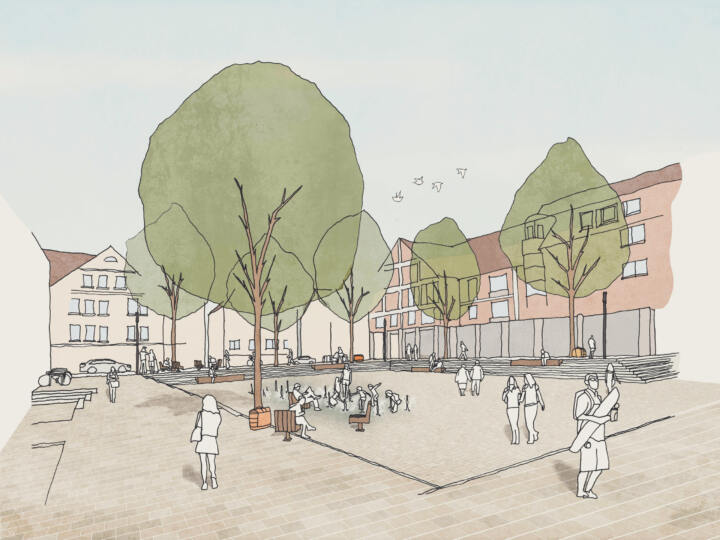
Material and Equipment
Currently, irregular paving and vegetation structures lie in front of the building facades.
paving and vegetation structures. The open space is defined by a targeted use of different floor coverings and materials to mark use and functional areas and at the same time to achieve a uniform coordinated appearance. The area of large stone pavers marks the movement space between the adjacent stores, the town hall and the streets. The inner plaza of natural stone forms the recreation area and provides space for markets, festivals and other events. The furniture and equipment is robust and timeless. The fountain area changes the microclimate. Visitors can cool off by the water or watch it from a distance and enjoy the relaxing effect of the water. The water feature will also be well received by children, who will enjoy visiting this space to romp and play. Four flagpoles and the new position of the memorial plaque in front of the town hall complete the square.
6-Lakes Wedau - Quarter at the water tower | Duisburg
1. Prize I 6-Lakes Wedau – Quarter at the water tower
Duisburg
In collaboration with Druscke und Grosser Architektur
The new residential quarter in Duisburg, with a water tower as an identity-forming element, will offer residents sustainable and future-oriented living space in the future.
In addition to a unique urban and open space planning concept, the issue of sustainability plays a decisive role.
Urban planning concept
Two ensemble groups are created, the so-called ‘neighborhoods’, which are linked via the centrally running Planstrasse C and the pedestrian and bicycle paths. Semi-public green spaces with different uses for the residents are assigned to the neighborhoods. Thus, open spaces with opportunities for play and recreation as well as urban gardening areas are created. The public area is dominated by the surrounding parking area. In addition, two plaza areas will be created to the north of Plan Street C and a mobility station to the south.
The creation of the two new communities will initiate a high level of communication among residents and strengthen the social aspects of the neighborhood. Architecturally, this is created in part by the diverse community uses located on the first floor. Among other things, youth rooms, community rooms as well as KiTa and small retail stores are planned. Above these, apartments with balconies will be realized. The outdoor space also invites interaction with each other through the shared play areas, urban gardening areas, tenant gardens and parking areas.
Sustainibility
In addition to social aspects and the promotion of these, the issue of sustainability plays a major role. The aim is to make the building as CO2-neutral as possible and to achieve the EH40 energy-efficient house standard. This is achieved primarily through the choice of a compact building structure with an advantageous A/V ratio. In addition, the roof surfaces will be green.
The importance of sustainable design can also be seen in the exterior. The new buildings blend harmoniously into the existing park and green structures. In addition, only a small amount of surface area is sealed and planting that promotes biodiversity is aimed for.
Landmark Turbine factory | Mannheim
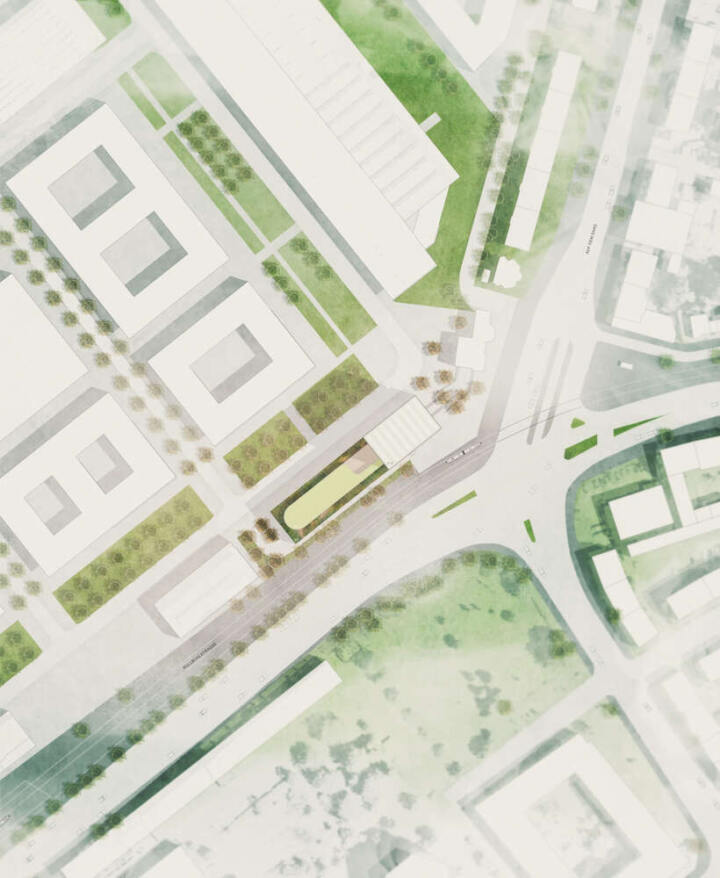
3. Prize I Landmark Turbine factory
Mannheim
In collaboration with netzwerkarchitekten GmbH
The ‘landmark building’ is designed as a floating volume above an elongated 6-storey plinth building. The base provides the boulevard extension of Rollbühlstrasse with an urban setting and enables the clear contouring of the turbine plant area. An inviting and flexibly usable ground floor zone enables the landmark formation and public activation of the quarter with restaurant and outdoor catering.
The entrance foyer of the high point opens up in a glass corner. Here, a generous staircase spans the historic gatehouse and marks the urban opening into the turbine factory. A special floor with a lush green roof garden for the conference area is inserted via the ‘horizontal cut’ in the building cubature. Ceramic pilaster strip in the color canon of the bricks are an identity-forming link to the Turbinenwerk area.
Lageplan © GTL, netzwerkarchitekten
Family Center, Learning Workshop and Daycare Center, Waldau Campus | Kassel
1st Prize I Family Center, Learning Workshop and Daycare Center, Waldau Campus
Kassel
In collaboration with pape + pape architekten
The L-shaped building forms two structural angles parallel to the northern and western boundaries of the site, creating an inviting forecourt encompassing an entrance area under a canopy. This attractive outdoor space can be used for big events. Large glazed openings in the learning workshop, in the multifunctional room, and facing the campus grounds generate transparency, allowing the building to enter into direct dialogue with its surroundings.
The building volume and interior layout of the new family centre lay down clear categories and zones within the open space. A spacious forecourt has plenty of room for parents’ daily chat and, when the occasional performance takes place, offer somewhere to meet and talk during the interval. A lounging deck, slightly off to the side, is destined to become a popular meeting place for the kids.
On the quieter east side child-friendly bench-table combinations offer space for doing homework or craft activities outside. Between the new building and the gymnasium there is an outdoor playground and romp area for the daycare children. A linear playground sculpture offers opportunities for all age groups to stimulate all their senses through play, via various climbing and balancing options over the covered sandpit, to cosy boxes to which children can retreat.
A contiguous area of undulating lawn provides space where kids can whizz around and leap about. If necessary, the area for the under-3s can be separated off from the rest of the playground by low wooden gates. This area has its own sandpit with a deck, a playhouse and a small grassy slope with a slide for toddlers. The terrace in the eating area is set in a vegetable patch or ‘snack garden’ that provides a rich supply of delicious fruit and herbs, screened from the rest of the grounds by low fruit hedges. Fruiting shrubs and trees also grow on other parts of the site.
"Blasius-Blick" residential district, Kaufbeuren
1. Price | “Blasius-Blick” residential district
Kaufbeuren
This new residential district in Kaufbeuren, located near the old town centre, is designed to offer future residents an attractive, locally rooted, and climate-friendly area in which to live. In all aspects of the project, attention has been focused on providing accessibility for all and contemporary design.
The Märzenbach stream has been used as a structuring element in the landscape design, and proposed re-wilding will turn it into a natural and attractive asset. The spaces between the residential buildings visually flow into each other through a sequence of trees, flowering meadows, paths and other green spaces, all designed to echo the stream’s character. Alongside play equipment for children, there is also potential for games and recreational facilities for people of all ages in the public space located at the core of the neighbourhood’s landscape. The inclusion of picnic tables, among other things, encourages social interaction. In contrast, there are generous private gardens too, located at a discrete distance from the residents’ green space.
Private cars have been kept out of the neighbourhood and links established to major existing networks of footpaths and cycle paths. In addition, bicycle-parking facilities are available at various locations. Nevertheless, access for emergency vehicles, delivery traffic and other traffic for all newly proposed areas and buildings is achieved via safe and reliable routes with appropriate surfacing used for access and in the vicinity of buildings. These hard-landscaped areas are kept to a minimum since they serve only this purpose as well as providing accessible approach routes, with alternating cellular paving and greenery blending harmoniously together.
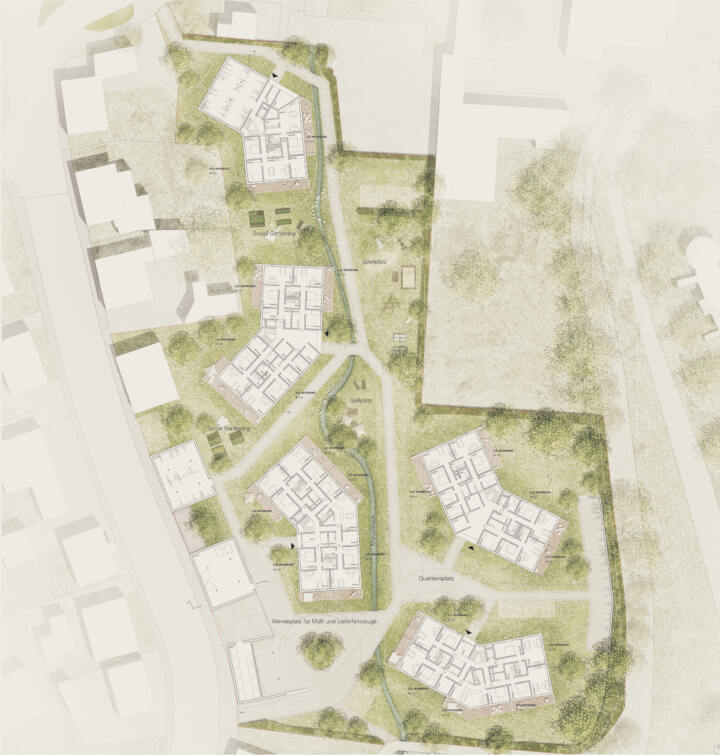
The theme of landscape runs throughout the entire residential quarter, and assembling the residential buildings in a meandering arrangement helps to give contour to the overall urban structure. The screening buildings located along Kemptener Strasse serve to buffer the area, creating a quieter and more sheltered environment within. It is imperative that the proposed apartments should not only be climate friendly, but affordable and attractive too. Responding to the outdoor spaces, apartments are oriented two ways, offering a range of views of the Blasiusberg and historical buildings beyond the immediate neighbourhood. Individual blocks are ideally suited to this, with their compact structure, monolithic construction method and energy efficiency, as well as step-free access.
The current tendency to work from home is taken into account in this forward-looking design concept by providing ‘joker’ rooms that offer people the option to work from home, or to use their space more flexibly. Through a mix of various-sized apartments, a social blend can be created, which helps to underscore the goal of creating stable, communal living.
Through the combination of compact buildings, a simple and thermally robust monolithic construction method, regenerative energy sources, and an energy-efficient BlueGreen building and landscaping concept, this project guarantees a forward-looking climate-friendly development.
